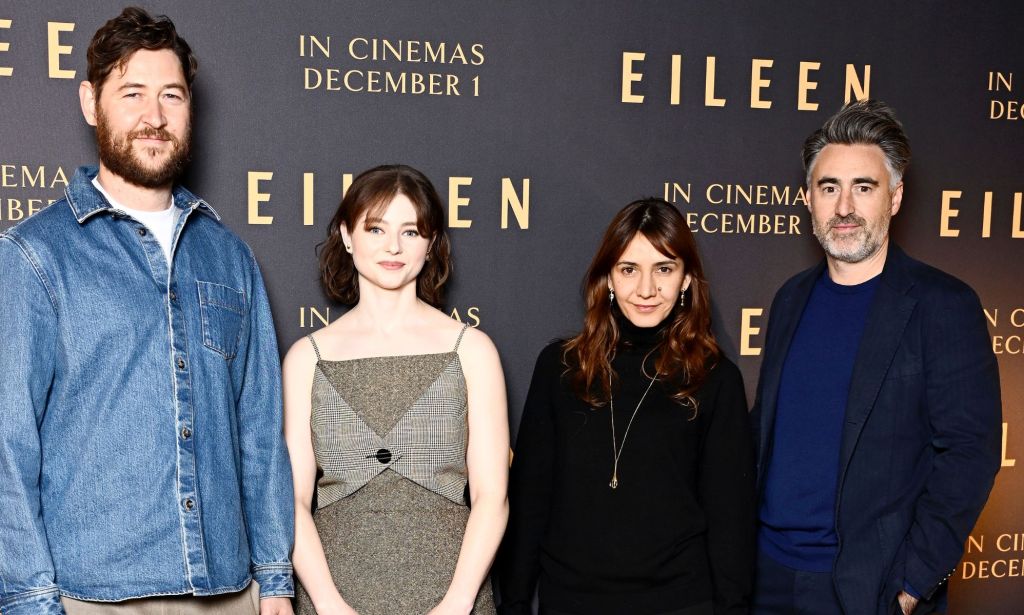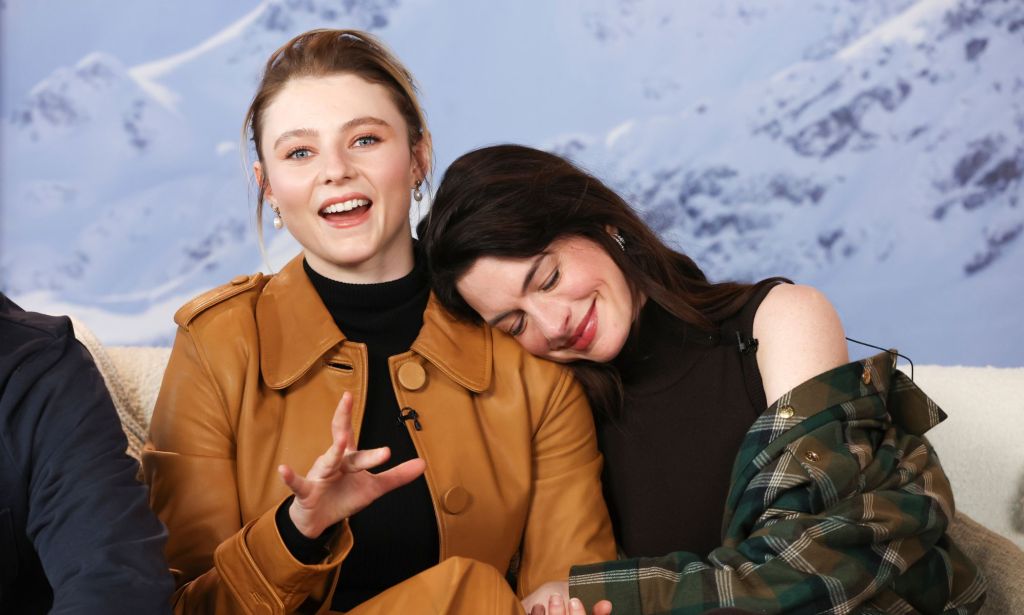How Eileen’s Thomasin McKenzie and Anne Hathaway brought the twisted queer thriller to life

Anne Hathaway and Thomasin McKenzie in queer thriller Eileen. (Universal Pictures/Penguin Press)
Ottessa Moshfegh’s brilliantly twisted debut novel Eileen comes to life in a new film adaptation from Lady MacBeth director William Oldroyd, and starring Thomasin McKenzie and Anne Hathaway.
It’s a snowy December day in 1960s New England when Eileen – which hit UK cinenas today (1 December) – begins. The titular character, played by Jojo Rabbit star Thomasin McKenzie, is taking pleasure watching a young couple make out in their car.
She’s taking so much pleasure, in fact, that she has to open her car door, lunge for a handful of snow, and stuff it into her underwear to cool herself off. The opening scene sets the tone for William Oldroyd’s take on Ottessa Moshfegh’ peculiar Man Booker Prize-shortlisted 2015 novel.
Written by Moshfegh and her husband Luke Goebel, the film follows the book’s plot almost exactly. Eileen Dunlop is an oddball, working at a prison for young men. Her life is dull and mundane, punctuated only by her aggressive, drunkard father, her thoughts of killing her aggressive, drunkard father, and occasional sexual fantasies about one of the prison’s guards.
That is until Rebecca, a glamorous, enigmatic new counsellor (played by The Devil Wears Prada‘s Anne Hathaway) arrives at the prison and takes Eileen under her wing. Slowly, Eileen becomes besotted – with tragic consequences.
PinkNews spoke to Thomasin McKenzie and William Oldroyd about Eileen being a queer film, chemistry with Anne Hathaway, and how they created one of the most enticing thrillers of the year.
What was it about Ottessa Moshfegh’s novel and the character of Eileen that made you want to turn it into a film?
William Oldroyd: Eileen was something I hadn’t seen on screen before and that is what I’m always interested in. Ottessa and Luke – I really loved when I met them. I thought: what a privilege to work with the novelist on adapting their own book.
With Thomasin, you’re always looking for characters that you know are going to attract great actors. I thought with Eileen, who’s not going to want to play this fantastic role?
Thomasin McKenzie: I read the script and read the book for Eileen the character. She is so complicated and a very troubled person, and I was drawn in by that, by wanting to know more about her and feeling really badly for her as well for having such a rough existence. I just wanted to care for her, in a way. Her life could have been so different, had she not been born in that place, at that time, in that family.
Ottessa Moshfegh has previously said that Eileen isn’t a freak character – she’s an honest character. Do you perceive her in that way?
Thomasin McKenzie: She’s very much a creature that’s been born of her environment – she’s just reacting as I think many people would to a life that’s very dark and grim and lonely. I don’t think she’s strange or weird. She’s a bit quirky, a bit odd. She’s not the kind of person that you’d stop and stare at in the street – she is who everyone is when they’re not being observed.

Thomasin, I read that you contacted a clinical psychologist to learn about what Eileen would be diagnosed with if she were a real person. How did that inform your take on the character?
Thomasin McKenzie: It was really amazing for me to have this communication with the clinical psychologist. The insights that she shared with me – on the days where I was feeling a little bit confused or lost, I was able to return back to what those insights were, so I could have an anchor.
When we were filming, I was doing a psychology paper at university, and so having educated myself a little bit on psychology as well, helped me bring some really some interesting insight to what was going on internally as well [in] her genes.
William, as Eileen the novel is an internal monologue, how did you manage to translate that into a film?
William Oldroyd: You can’t get it all, because the entire book is told from first person point of view. So you just choose the bits that are essential. We spent some time a few days before we were shooting [where] we sat and we’ve chatted about the character, and crucially, what each thought was.
We went through the script so that we could be really clear that we were making sure that Eileen was thinking the right thing in each moment. What you hope – and that’s why when you have great actors, it works so much better – you hope that when the thought is clear, it transmits through the face, onto the camera, and it’s clear for our audience.

Eileen has been dubbed a queer novel and film by the LGBTQ+ community because of Eileen’s infatuation with Rebecca. Do you agree that it’s a queer storyline?
William Oldroyd: I’m happy for people to interpret the work of art as how they wish. I’m thrilled that people take this away from the film. It’s a complicated relationship; I’m interested to see what other people think of the relationship.
For me, it’s really rooted in obsession. I think that Eileen is somebody who really doesn’t have a role model in her life, she doesn’t have a mother or a sister or any friends, or a lover. When Rebecca rolls into town, she loads all of those [people] onto this one person.
No relationship can sustain that sort of pressure. I think inevitably we see the fallout from that.
Thomasin McKenzie: I’m really excited by it! I’m really stoked and really honoured that the LGBTQ+ community has embraced it.
What does the fact that Eileen is such a one-sided infatuation add to the plot?
Thomasin McKenzie: It really adds to the thriller aspect of it… because everything we’re seeing is through Eileen’s perspective, which is a very skewed perspective. It’s a conversation about how things can be intended and how differently they can be received.
William Oldroyd: We have the privilege of spending 90 minutes inside the head of this young woman. When she’s surprised by something that Rebecca does, we feel it because we may anticipate the tragedies to come, but we’re not sure.
For me, some of the strongest stories are really told from a singular point of view. I think if we’d seen any of Rebecca’s life outside of Eileen, I think we wouldn’t have felt the impacts so greatly of what happens to Eileen.

Thomasin, how did you and Anne Hathaway work together to build the connection between your two characters?
Thomasin McKenzie: I think our natural personalities lend themselves pretty well to the two roles. How I perceive Anne is [that] obviously she’s stunning, she’s incredibly stylish, she’s very elegant. She’s someone you want to listen to. She’s got a lot of wisdom and experience.
I’ve always considered myself to be a little bit awkward and quirky; everything that’s going on in my mind is so clear. Which is great for me in terms of my career, but we’re just very different people. She is someone I’ve grown up watching on the screen and being amazed by, so it’s just very exciting.
William Oldroyd: The way in which we structured the shoot was interesting. We worked with Shea [Whigham], who plays Eileen’s father, and with Thomasin before Christmas, then had a two-week break for Christmas, and then we shot the scenes with Eileen and Rebecca.
The first day [Thomasin] and Anne shot together was the scene in the bar, where they go on a date. So actually, all of the natural awkwardness of [them] meeting for the first time was present.
[Thomasin] said to me that [she] did look up to Anne, and that’s not dissimilar from the relationship between Eileen and Rebecca – that she looked up to her.
Eileen is out in cinemas now.
This interview has been condensed for clarity.
How did this story make you feel?

